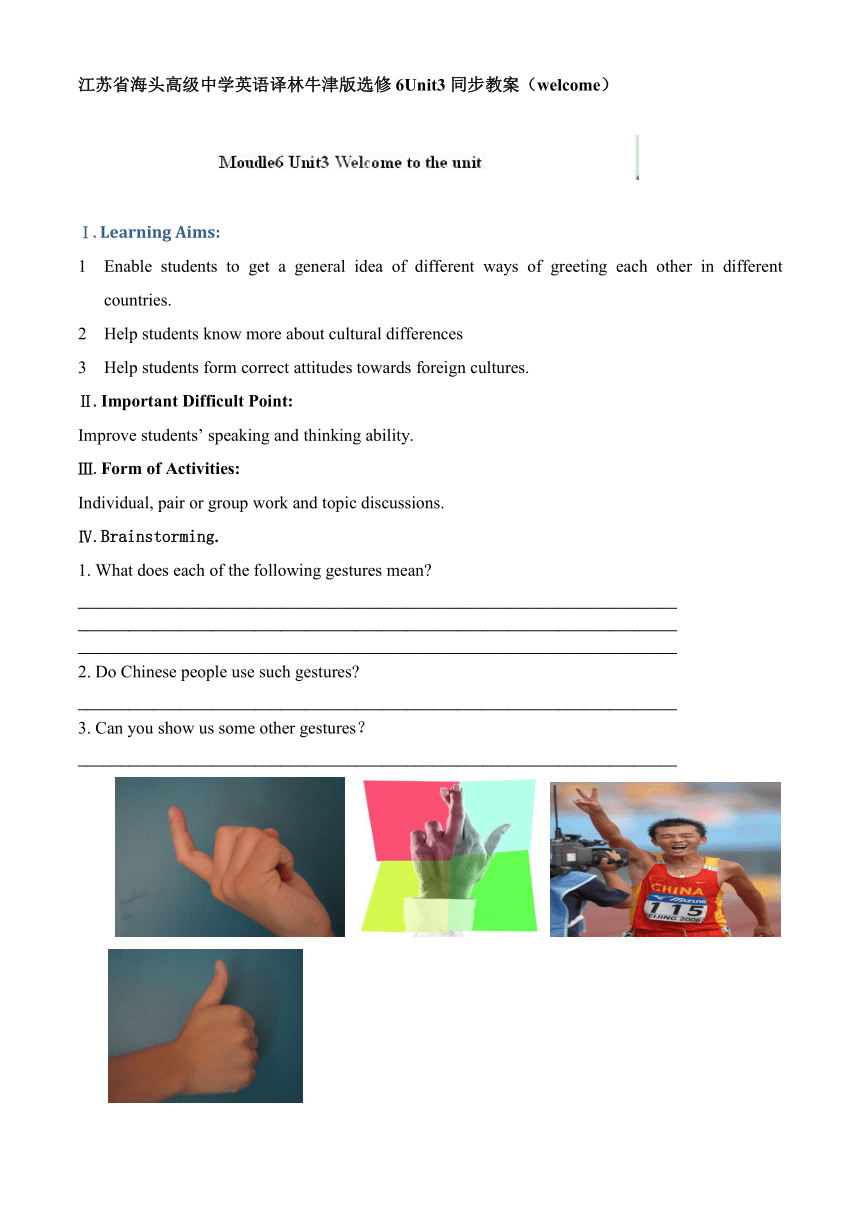江苏省海头高级中学英语译林牛津版选修6Unit3 Understanding each other同步教案(welcome)
文档属性
| 名称 | 江苏省海头高级中学英语译林牛津版选修6Unit3 Understanding each other同步教案(welcome) |  | |
| 格式 | zip | ||
| 文件大小 | 1010.4KB | ||
| 资源类型 | 教案 | ||
| 版本资源 | 牛津译林版 | ||
| 科目 | 英语 | ||
| 更新时间 | 2014-05-16 09:18:26 | ||
图片预览

文档简介
江苏省海头高级中学英语译林牛津版选修6Unit3同步教案(welcome)
Ⅰ. Learning Aims:
Enable students to get a general idea of different ways of greeting each other in different countries.
Help students know more about cultural differences
Help students form correct attitudes towards foreign cultures.
Ⅱ.Important Difficult Point:
Improve students’ speaking and thinking ability.
Ⅲ.Form of Activities:
Individual, pair or group work and topic discussions.
Ⅳ.Brainstorming.
1. What does each of the following gestures mean?
_______________________________________________________________________
_______________________________________________________________________
_______________________________________________________________________
2. Do Chinese people use such gestures?
_______________________________________________________________________
3. Can you show us some other gestures?
_______________________________________________________________________
Ⅴ. Picture Talking
1. Talk about the six pictures ( TB p33) in pairs or groups focusing on the ways of specific greetings.
_______________________________________________________________________
_______________________________________________________________________
_______________________________________________________________________
_______________________________________________________________________
_______________________________________________________________________
_______________________________________________________________________
Ⅵ.Questions.
How do we Chinese usually greet each other now?
_______________________________________________________________________
Ⅶ. How do people from different countries greet each other?
(Fill in the form)
nationality
way of greeting
Thailand
?
South America
?
The Middle East
?
The USA
?
Dutch
?
Japan
?
A: It’s strange/ interesting/fascinating/ funny that….
What do you think?/How do you find it?/
What’s your opinion about…?
B: I agree. / I think it’s good manners/polite/acceptable to…
Well, I think it’s just like the way we …
Sorry I don’t think so./ It’s bad manners/ rude/not acceptable to…
_______________________________________________________________________
_______________________________________________________________________
_______________________________________________________________________
_______________________________________________________________________
Ⅷ. Discussion:
Why do you think that we should learn cultural differences between different nations?
_______________________________________________________________________
_______________________________________________________________________
_______________________________________________________________________
_______________________________________________________________________
2. Which of the following words indicate the right attitudes towards cultural differences?
respect B. tolerate C. look down upon D. appreciate E. hate F. understand G. reject
Through discussion please form correct attitudes towards foreign cultures.
______________________________________________________________________________________________________________________________________________
_______________________________________________________________________
_______________________________________________________________________
Ⅸ. Consolidation.
1. A guessing game: (Match the idioms with its meaning).
( )1. With open arms.
( ) 2. To keep a straight face. a. To disregarding sth.
( ) 3. To put your heads together. b.To be involved in a project that is too difficult. ( ) 4. To be all ears. c To act casually, to be oneself.
( ) 5. To shrug something off. d To listen attentively.
( ) 6. To be in over one’s head. e. To work together with someone;
( ) 7. To keep one’s nose out of f. to share information.
someone’s business g .Not to show one’s true feeling; not to laugh
under most circumstances.
( ) 8. To pull a long face. h .To show that one is annoyed.
( ) 9. To let one’s hair down. i .To pay attention to only one’s own concerns.
j .In a welcome and enthusiastic manner.
Ⅰ. Learning Aims:
Enable students to get a general idea of different ways of greeting each other in different countries.
Help students know more about cultural differences
Help students form correct attitudes towards foreign cultures.
Ⅱ.Important Difficult Point:
Improve students’ speaking and thinking ability.
Ⅲ.Form of Activities:
Individual, pair or group work and topic discussions.
Ⅳ.Brainstorming.
1. What does each of the following gestures mean?
_______________________________________________________________________
_______________________________________________________________________
_______________________________________________________________________
2. Do Chinese people use such gestures?
_______________________________________________________________________
3. Can you show us some other gestures?
_______________________________________________________________________
Ⅴ. Picture Talking
1. Talk about the six pictures ( TB p33) in pairs or groups focusing on the ways of specific greetings.
_______________________________________________________________________
_______________________________________________________________________
_______________________________________________________________________
_______________________________________________________________________
_______________________________________________________________________
_______________________________________________________________________
Ⅵ.Questions.
How do we Chinese usually greet each other now?
_______________________________________________________________________
Ⅶ. How do people from different countries greet each other?
(Fill in the form)
nationality
way of greeting
Thailand
?
South America
?
The Middle East
?
The USA
?
Dutch
?
Japan
?
A: It’s strange/ interesting/fascinating/ funny that….
What do you think?/How do you find it?/
What’s your opinion about…?
B: I agree. / I think it’s good manners/polite/acceptable to…
Well, I think it’s just like the way we …
Sorry I don’t think so./ It’s bad manners/ rude/not acceptable to…
_______________________________________________________________________
_______________________________________________________________________
_______________________________________________________________________
_______________________________________________________________________
Ⅷ. Discussion:
Why do you think that we should learn cultural differences between different nations?
_______________________________________________________________________
_______________________________________________________________________
_______________________________________________________________________
_______________________________________________________________________
2. Which of the following words indicate the right attitudes towards cultural differences?
respect B. tolerate C. look down upon D. appreciate E. hate F. understand G. reject
Through discussion please form correct attitudes towards foreign cultures.
______________________________________________________________________________________________________________________________________________
_______________________________________________________________________
_______________________________________________________________________
Ⅸ. Consolidation.
1. A guessing game: (Match the idioms with its meaning).
( )1. With open arms.
( ) 2. To keep a straight face. a. To disregarding sth.
( ) 3. To put your heads together. b.To be involved in a project that is too difficult. ( ) 4. To be all ears. c To act casually, to be oneself.
( ) 5. To shrug something off. d To listen attentively.
( ) 6. To be in over one’s head. e. To work together with someone;
( ) 7. To keep one’s nose out of f. to share information.
someone’s business g .Not to show one’s true feeling; not to laugh
under most circumstances.
( ) 8. To pull a long face. h .To show that one is annoyed.
( ) 9. To let one’s hair down. i .To pay attention to only one’s own concerns.
j .In a welcome and enthusiastic manner.
